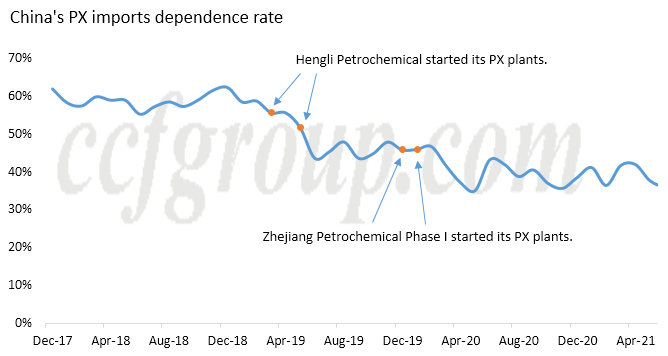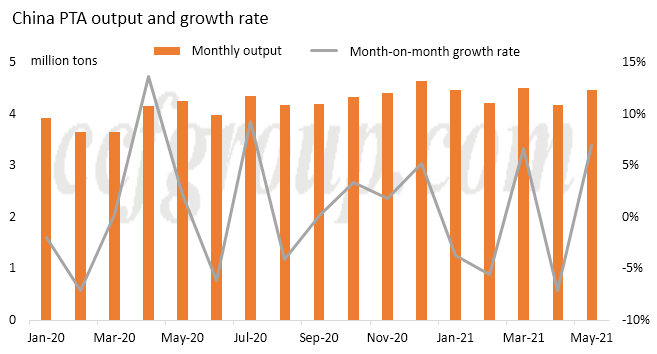How will the new plants impact PX and PTA
There’s been a lot of talk about new PX and PTA plants in China. It is anticipated that Zhejiang Petrochemical Phase II’s first 2.5 million mt/yr PX line and Yisheng New material’s 3.5 million mt/yr PTA unit are about to start soon. Though there’s no official confirmation, the market is reacting with PX paper goods softening and PTA spot to futures spread weakening slightly on Jun 15.
Some PX market participants said that as there will be a fresh 3.5 million mt/yr PTA plant, the increase in PX production due to Zhejiang Petrochemical’s new plant could be largely digested. The new PTA plant would require 2.3 million tons of feedstock PX when running full swing (to produce 1 ton of PTA requires 0.66 tons of PX), hence, with both plants put into operation, the increase in PX production caused by the new plants are expected at 200kt a year, equivalent to 10~20kt a month. The impact on PX market would be limited, and with the plant starting as expected, the impact was cushioned. In addition, crude oil price remains firm, lending support to PX market.
Theoretically, with the startup of new PX plant, China domestic PX capacity would expand by 9.3% and monthly production would increase by about 200kt. As shown in the chart below, the increase in domestic production could lead to drop in PX imports and reduced dependence on PX imports.

As for PTA, the impact could be more obvious.
Since the first quarter of 2021, there’s has been 5 million mt/yr of new PTA capacity on stream in China, while new polyester capacity is only 2.42 million mt/yr. PTA profits have been squeezing fast, leading to some PTA plants cutting production or even shutting down.

With PTA capacity expansion already outpacing that of polyester, the Yisheng’s new PTA plant could lead to further competition in the market. PTA profit is still under pressure and may squeeze further.
With PTA plants already under losses, the new plant could result in decline in average PTA plant operating rate, with some plants shutting due to squeeze of profits.
News said that Zhejiang Petrochemical’s new PX plant could get PX in late Jun or early Jul, and Yisheng’s new PTA plant may intake feedstock from the week ending Jun 18. Then, PTA production could materialize prior to PX.
If the plants are started as expected, China PTA inventory could increase by about 60kt in Jun, based on polyester plant operating rate at around 91.5%. However, as some plants could shut for maintenance or cut operating rates in Jul, PTA inventory could increase slightly and supply and demand could be broadly balanced that month.
As for PX, the inventory may increase by 50-100kt in Jun, as massive plant maintenance is unlikely due to relatively good profits. In Jul, however, with the new plant on line, China PX inventory could rise 250kt that month.
In a conclusion, with new plants coming on stream, old PTA plants could be affected in the short term, while it would take a longer time for PX supply overhang to be relieved and PX-naphtha spread remains under pressure.
In terms of price, from late May to Jun 15, Brent crude futures have advanced 15%, naphtha gained 12%, PX risen 5% while PTA only increased 3%, reflecting squeeze of profits in the industry. PTA plants are currently under losses, and PX-MX is also below break-even line. Crude oil paints a rosy picture, with the deployment of vaccines in Europe and US, recovery of global demand as well as OPEC+’s refraining from increasing outputs. Hence, PX industry chain could continue being supported by the cost.
The forecast above are based on the market news about the startup of new plants. It is still dependent on official announcement.
- Top keywords
- Cotton Price
- Cotton Futures Price
- Cotton Futures
- CZCE
- PTA Futures Price
- Chemical Fiber
- Polyester Prices
- Wool price
- PTA Futures
- Shengze Silk
- China
- Yarn Price
- price
- China Textile City
- Fibre Price
- Benzene Price
- Cotton
- Index
- Cotton Index
- PTA
- fabric price
- NYMEX
- Top 10
- textile industry
- Spot Cotton
- Cotton Yarn
- Polyester Price
- Futures
- PTA Price
- cotton yarn price

